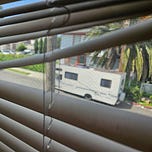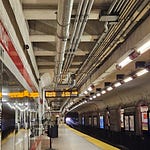Los Angeles, CA, April 24, 2024
I’ve been hanging out with my partner in LA when I can between trips this spring. I don’t teach this term. He lives near to the University of Southern California (USC) in a neighborhood with taco trucks, broken down cars being worked on, gas stations, Mexican groceries, brow threading or waxing shops, and a really good little coffee shop. His apartment building is surrounded by working class families’ bungalows and also by heavily renovated and gentrified houses and apartment buildings—all advertising leases to USC students. Amidst the poor and working-class people’s cars, there are Porsches, Teslas, Audis, etc. I saw this car a few months ago sputtering through the neighborhood; it beat ANY rez car hands down for the way it was falling apart and ingeniously held together. I wish I had a photograph! I didn’t want to offend the guy driving it though by taking a picture of his incredible work without permission. It even beats the minivan I saw once on the Crow reservation in Montana with its headlights gouged out. That vehicle was booking down the access road next to the freeway, clearly trying to get somewhere before the setting sun disappeared. I laughed so hard as I whooshed down the freeway in the opposite direction in my little blue Toyota isolation capsule. I was headed back to Edmonton from Colorado where my daughter was in junior college high up in the Rocky Mountains.
Cue up Keith Secola’s classic song NDN Kars! Here is a sample verse:
My car is dented, the radiator steams
One headlight don't work, the radio can scream
I got a sticker says "Indian Power"
I stuck it on my bumper, that's what holds my car together
We're on a circuit of an Indian dream
We don't get old, we just get younger
When we're flying down the highway
Riding in our Indian Cars
It’s been difficult to remotely record my regular podcast, Media Indigena, when I am here near downtown LA. The city’s sound effects are on a continual loop: police helicopters overhead, loud engines roaring down the residential streets (I’m waiting for the ear-piercing screech of tires and loud, crunching, crash), and sirens screeching by. There is the tamale lady coming by everyday, yelling down the street in her characteristic way “ta-mah-LAYYYY!!” And there are homeless people yelling in the street for sustained periods. Last week a woman with a trench coat on and a huge backpack stood in the shade of a tree half a block away and yelled toward the intersection for about 20 minutes. Then she suddenly stopped, and walked away down the street. I think she was speaking English, but I couldn’t hear her words clearly. Also last week, the guy who lives in his RV that is always parked across the street was having a meltdown in Spanish. He sat on the back bumper of the RV and screamed angrily for 90 minutes or so at no one we could see. My partner said he’d never done that in all the months he’s been parking there, and that he was mostly swearing at something. We are grateful to have a roof over our heads, as humble as it is.
I am bunking with friends in Edmonton too. I sold my condominium in January. My daughter’s University of California out-of-state tuition plus her exorbitantly priced UC housing costs a good chunk of my yearly income. Her dad and I want to pay it off in a few years max. Plus the guy who owned the condo upstairs from me was constantly overflowing his toilet or kitchen sink. I had several instances of water pouring down into my condo. He’s going to cause major water damage. It also sounds like a herd of howling elephants up there every time an Oilers game is on. His cigarette and weed butts ended up falling from his patio down into my patio plants. And he was always yelling at his kid. The guy is a menace. I’ve also owned two homes, one near my rez, and a way overpriced bungalow in Berkeley when I taught at UC. I’ve lost money on all three places. I have decided the property owner life is not for me. I’m also on the road half the time and that won’t change before retirement. I am making my peace with being both rooted in prairie landscapes, and also unsettled. Finally, did you hear about that one structurally unsound condominium in Edmonton that had to be evacuated ASAP? The condo owners may lose everything.
I told my partner today that I realized that whereas he feels safer living in the same apartment for more than two decades after experiencing homelessness as a child, I feel safer no longer being a property owner. I’m spreading my risk of loss of life and stuff across multiple locations. My stuff lives between my office, friend’s house, and storage unit in Edmonton; my partner’s house in L.A.; my aunt’s house in Dakota homelands in Minnesota; and soon also in my daughter’s off-campus rental house in Santa Cruz. She’s getting some pretty good furniture. My mother recently said she should not have moved so much when we were kids; now look at me. I remember my great grandmother asking my mother exasperatedly, “LeeAnn, must you always be such a vagabond?” Granny would be shaking her head at me too. But is it my fault that the people I love live all over the place? And I’ve learned that I see the good things both north and south of the US-Canadian settler border when I am routed across them. Staying too long on one side or the other of that border, I get cranky with both places.
Los Angeles (LAX) to Edmonton (YEG), April 25, 2024
Sitting in the gate area before my evening flight to Edmonton tonight, I felt a sense of dread, like I am doing something vaguely immoral. I’ve been feeling that increasingly when I get on these planes so often. I am resigned, but not complacent with this way of living.
I read Pico Iyer’s The Global Soul: Jet Lag, Shopping Malls, and the Search for Home (2001) right after I returned from a couple of years living on West Java in Indonesia and from jet setting around the world—or parts of the world: Asia, Europe, and North America. I was in my early 30s; I don’t remember much about the book, except I recognized parts of my strange, unexpected, and highly mobile life in it. I had grown up in a world where people rarely flew. A five-hour drive to Minneapolis to see a sporting event or to go ride a roller coaster was a big deal in my small South Dakota town in the 1970s and 80s. It was at first a shock and also intriguing to become a global soul in the late 1990s. A quarter century later, this way of living no longer feels shocking, although new places, customs, foods, smells, and manners can still intrigue or feel challenging. Travel now often feels more like testing my Boeing-related fate and spinning fossil-fueled wheels. Of course, I still meet many thoughtful people in the places where I travel. But people are people, no matter where you go. I also fly to be with those I love. I am pretty sure that sitting in one place would feel no less like a hamster wheel? That state of being is probably linked to highly bureaucratized work and scrambling within a capitalist world system, which air travel is only one part of. I should revisit Pico Iyer’s book and see how it lands now.
Tonight, I fly back to where I work, to where I share more intellectually and morally with a community of scholars than I’ve found elsewhere. Several months ago, at a meeting of high-level administrators at the University of Alberta, I had to give a talk on the Indigenous Science and Technology Studies (I-STS) programs we have developed in our Faculty of Native Studies. From my perspective, I make them sound very exciting! I also mentioned that I have both conceptual and structural support for such a program here that I will not find in most US universities. One of the individuals in a suit and tie asked me what keeps me in Alberta. What a funny question, I thought. Hadn’t I just given the reason?
I elaborated. The problem is not chiefly conceptual that divides the US from the Canadian terrain in Indigenous or Native Studies programming, meaning there is good Indigenous Studies theory happening in the academic scene of both countries. Rather, I think it’s the much greater visibility that “Indigenous” issues have on the national radar in Canada than in the US. This is chiefly about numbers as far as I can tell. First Nations, Métis, and Inuit people are a greater proportion of the overall Canadian population than are Native people in the US. There are other contributing factors in the racial and ethnic landscape of both countries that make it different in terms of Native peoples’ visibility in Canada and greater invisibility in national political conversations in the US, but numbers are a significant factor. Kevin Bruyneel’s Settler Memory: The Disavowal of Indigeneity and the Politics of Race in the United States (University of North Carolina Press, 2021) also sheds light on the fascinating differences, if you are interested.
My family will never join me in Edmonton. But it is obvious why it has been a very good place to think and build something. Just not a house.











